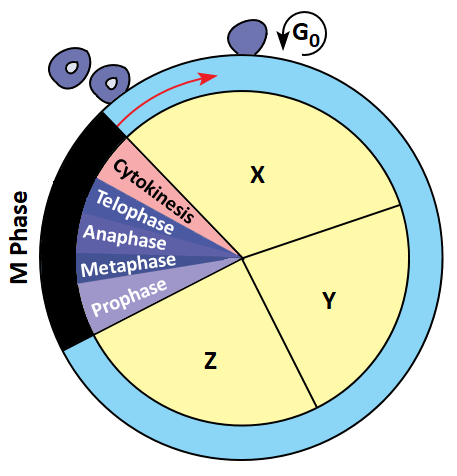Cytokinesis in animal cell takes place by _______; in _______ direction while in plant cell by _______; in _______ direction:
1.
Furrowing, centrifugal, cell plate, centripetal
2.
Furrowing, centripetal, cell plate, Centrifugal
3.
Cell plate, centrifugal, furrowing, centripetal
4.
Cell plate, centripetal, furrowing, centrifugal
Liquid endosperm in coconut is resulted due to:
| 1. | Karyokinesis followed by cytokinesis |
| 2. | Failure of karyokinesis followed by cytokinesis |
| 3. | Karyokinesis twice followed by single cytokinesis |
| 4. | Karyokinesis is not followed by cytokinesis |
The above graph shows the change in DNA content during various phases (A to (d) in a typical mitotic cell cycle. Identify the phases:
|
|
A |
B |
C |
D |
|
(1) |
G2 |
G1 |
S |
M |
|
(2) |
G |
S |
G2 |
M |
|
(3) |
G1 |
S |
G2 |
M |
|
(4) |
M |
G1 |
S |
G2 |
A reduction step during meiosis is important because:
| 1. | It returns the chromosome number to normal before fertilization |
| 2. | There is a mechanism for this |
| 3. | Only one copy of each chromosome is necessary |
| 4. | Otherwise chromosome copies would double each fertilization |
The DNA content of individual cells and the number of cells in each phase of a "cell cycle" can be determined, using flow cytometry. Which of the following combinations of "phase of a cell cycle and its corresponding DNA content" can be considered normal?
| A. | Diploid cells found in the Go or G1 phase. |
| B. | Cells with twice the normal DNA content in the early M phase. |
| C. | Cells with intermediate amounts of DNA in the S Phase. |
| D. | Cells with twice the normal DNA content in the G2 phase. |
1. A and B
2. B and C
3. C and D
4. All are correct
The following diagram refers to a typical cell cycle.
Identify the parts marked as X, Y and Z.

| 1. | X - G1; Y - S; Z - G2 |
| 2. | X - G2; Y - S; Z - G1 |
| 3. | X - G0; Y - S; Z - G2 |
| 4. | X - G1; Y - G2; Z - G0 |
Identify the meiotic stage in which the homologous chromosomes separate while the sister chromatids remain associated at their centromeres:
| 1. | Metaphase I |
| 2. | Metaphase II |
| 3. | Anaphase I |
| 4. | Anaphase II |
Select the correct statement about G1 phase:
(1) Cell is metabolically inactive
(2) DNA in the cell does not replicate
(3) It is not a phase of synthesis of macromolecules
(4) Cell stops growing
Which of the following is a continuous process?
| 1. | Cell growth |
| 2. | Cell differentiation |
| 3. | DNA duplication |
| 4. | Cell division |
Cell growth is a continuous process in terms of
| 1. | Increase in protein content |
| 2. | Increase in DNA content |
| 3. | Increase in cytoplasmic content |
| 4. | Increase in RNA content |







